
|
You entered: Moon
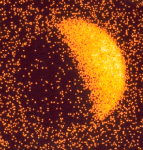 The X-Ray Moon
The X-Ray Moon
29.09.1996
This X-Ray image of the Moon was made by the orbiting Roentgen Observatory Satellite (ROSAT) in 1990. It shows three distinct regions: a bright X-ray sky, a bright part of the Moon, and a relatively dark part of the Moon. The bright X-ray sky is due to the diffuse cosmic X-ray background.
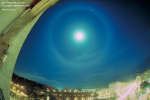 A Halo Around the Moon
A Halo Around the Moon
7.12.2008
Have you ever seen a halo around the Moon? This fairly common sight occurs when high thin clouds containing millions of tiny ice crystals cover much of the sky. Each ice crystal acts like a miniature lens.
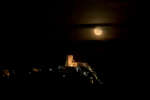 Castle and Full Moon
Castle and Full Moon
16.04.2009
Clouds couldn't hide this bright Full Moon as it rose last week over the medieval castle of Tourrette-Levens near Nice, France. Exactly full on April 9 at 1456 UT, it followed the March equinox, making it the first Full Moon of spring in the north and autumn in the southern hemisphere.
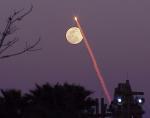 Shuttle Moon
Shuttle Moon
12.05.2001
As a gorgeous full Moon rose above the eastern horizon on February 7, the Space Shuttle Atlantis streaked skyward towards an orbital rendezvous with the International Space Station. Watching from Orlando, Florida, about...
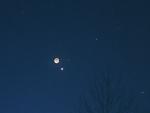 Moon, Mars, Venus, and Spica
Moon, Mars, Venus, and Spica
4.12.2002
Gliding toward today's total eclipse of the Sun, the crescent Moon has been rising early, just before dawn. And as a prelude to its close solar alignment, the Moon also completed a lovely celestial triangle, closing with bright planets Mars and Venus on the morning of December 1.
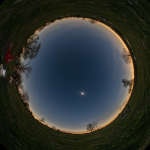 All Sky Moon Shadow
All Sky Moon Shadow
27.04.2024
If the Sun is up but the sky is dark and the horizon is bright all around, you might be standing in the Moon's shadow during a total eclipse of the Sun. In fact, the all-sky Moon shadow shown in this composited panoramic view was captured from a farm near Shirley, Arkansas, planet Earth.
 Earth, Moon, Hubble
Earth, Moon, Hubble
5.01.2000
The Space Shuttle Discovery Crew was fortunate enough to witness one of the brighter full moon's from orbit two weeks ago during their mission to fix the Hubble Space Telescope. Pictured...
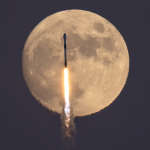 The Falcon and the Hunter s Moon
The Falcon and the Hunter s Moon
14.10.2022
The Full Moon of October 9th was the second Full Moon after the northern hemisphere autumnal equinox, traditionally called the Hunter's Moon. According to lore, the name is a fitting one because this Full Moon lights the night during a time for hunting in preparation for the coming winter months.
 Saturn with Moons Tethys and Dione
Saturn with Moons Tethys and Dione
31.05.1997
Saturn and two of its larger moons - Tethys and Dione - were photographed by the Voyager 1 spacecraft which flew by the planet in November of 1980. This picture gives an indication of Saturn's extensive ring system, which can be seen casting a shadow on the planet, as does Tethys.
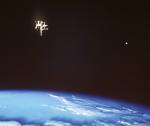 The Moons Of Earth
The Moons Of Earth
13.08.1998
While orbiting the planet during their June 1998 mission, the crew of the Space Shuttle Discovery photographed this view of two moons of Earth. Thick storm clouds are visible in the lovely blue planet...
|
January February March April |
|||||||||||||||||||||||||||||||||||||||||||||||||